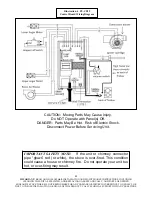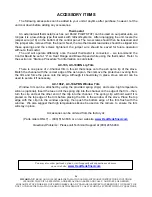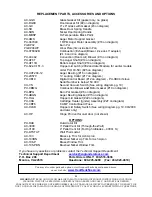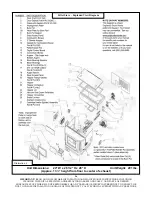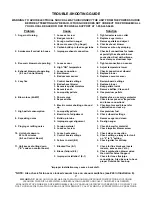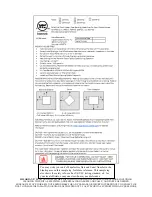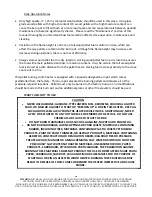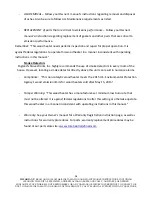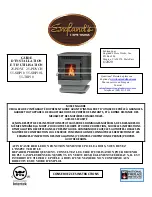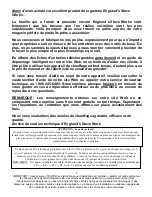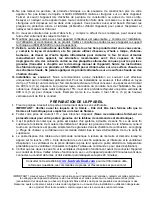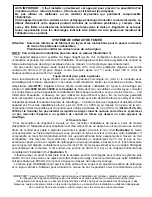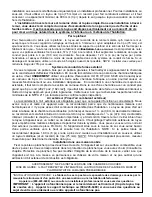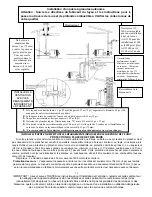
IMPORTANT!
READ AND FOLLOW
ALL
INSTALLATION AND MAINTENANCE INSTRUCTIONS, INCLUDING
CLEANING THE UNIT AS SPECIFIED, AND REPLACING GASKETS ANNUALLY, AND PARTS AS NEEDED.
ENGLAND’S STOVE WORKS IS NOT RESPONSIBLE FOR ANY DAMAGE OR INJURY INCURRED DUE TO NEGLECT, OR
DUE TO UNSAFE INSTALLATION OR USAGE OF THIS PRODUCT. CALL TECHNICAL SUPPORT WITH ANY QUESTIONS.
35
OUTSIDE
AIR
HOOK
‐
UP
The
use
of
outside
combustion
air
is
mandatory
on
this
pellet
stove.
The
outside
air
connection
pipe
protrudes
from
the
lower
rear
center
of
the
stove;
use
the
included
outside
air
kit
to
attach
your
stove
to
outside
combustion
air.
Instructions
and
all
the
parts
needed
to
make
the
outside
air
connection
to
your
pellet
stove
are
included
with
the
outside
air
kit.
If
it
is
not
feasible
to
use
the
included
outside
air
hookup
kit
in
your
stove
installation,
other
materials
may
be
used,
provided
the
following
rules
are
followed:
The
pipe
used
for
outside
air
hookup
must
be
metal,
with
a
minimum
thickness
of
.0209
in.
(25
gauge
mild
steel)
or
greater
and
an
inside
diameter
of
approximately
2.0
in.
All
pipe
joints
and
connections
should
be
sealed
with
pipe
clamps
or
other
mechanical
means,
to
insure
a
leak
free
outside
air
connection.
Long
runs
of
pipe
and
excessive
elbows
for
outside
air
should
be
avoided.
Due
to
frictional
resistance
in
pipe,
any
excessive
outside
air
piping
can
result
in
poor
stove
performance.
A
screen
or
other
protection
device
must
be
fitted
over
the
outside
air
termination
point
to
prevent
rain,
debris
and
nuisance
animals
from
entering
the
piping
system.
Increase
the
outside
air
pipe
size
to
3.0
in.
diameter
pipe
if
the
outside
air
connection
is
more
than
6
ft.
in
length,
more
than
two
(2)
elbows
are
used
or
if
the
stove
is
installed
in
a
basement.
The
outside
air
connection
system
should
be
inspected
at
least
annually
to
be
certain
it
is
free
from
blockage.
‐
Operation
and
Maintenance
–
Please
refer
to
the
‘Operation’
(Operating
Instructions)
and
Maintenance
(including
Ash
Removal/Disposal)
sections
of
your
owner’s
manual
and
follow
the
guidelines
listed
therein
for
safety
and
for
optimal
emissions
performance.
Additional
Information:
Following
the
instructions
in
your
owner’s
manual
for
Start
‐
Up
(lighting
a
fire)
will
ensure
a
proper
fire,
as
well
as
helping
minimize
visible
emissions.
More:
‐
Fuel
loading
and
re
‐
loading:
Practical
Tips
for
Building
a
Fire
–
See
your
owner’s
manual
for
information
on
loading
(and
re
‐
loading)
your
fuel,
as
well
as
for
fire
‐
starting
procedures.
‐
Fuel
Selection:
Once
your
appliance
is
properly
installed,
be
sure
to
follow
your
owner’s
manual
regarding
fuel
selection
and
starting
and
operating
your
appliance,
including
the
following
practical
tips
that
will
help
you
obtain
the
best
efficiency
from
your
stove.
Summary of Contents for 25-PDVC
Page 39: ......


